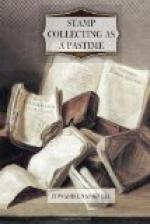The average series of used stamps are now so cheap that a lad may get together a fairly representative collection for what he ordinarily spends at the tuck shop. Some educationists have advocated the making and exhibiting of school collections of stamps as aids to study. Such collections would certainly be much more profitably studied than most of the maps and diagrams that nowadays cover the walls.
With few exceptions, every stamp has the name of the country, or colony, of its issue on its face; and most colonial stamps bear some family likeness to the stamps of the mother country. Our British colonial stamps are distinguished by their Queen’s heads; the stamps of Portugal and its colonies by the portraits of the rulers of Portugal; those of Germany by the German currency; those of France mostly by French heraldic designs; those of Spain by the portraits of the kings and queens of Spain. So that the postage stamp is a key to much definite, valuable, and practical information.
[Illustration:]
[Illustration:]
VI.
Its Historical Finger Posts.
When considered from the historical point of view, postage stamps attain their highest level of educational value. They are finger posts to most of the great events that have made the history of nations during the last fifty years. Here are a few out of many examples which might be quoted.
The introduction of adhesive stamps for the prepayment of postage found France a Republic. A provisional government had just been established on the ruins of the monarchy which had been swept out of existence in the revolution of 1848. As a consequence, the first postage stamp issued by France, on New Year’s Day of 1849, bore the head of Ceres, emblematic of Liberty. Three years later Louis Napoleon seized the post of power, and, as President of the Republic, his head figures on a stamp issued in 1851, under the inscription “REPUB. Franc.” Two years later the Empire was re-established, and the words “REPUB. Franc.” were changed to “Empire Franc.” over the same head. In 1863 the customary laurel wreath, to indicate the first victories of the reign, won in the war with Austria, was added to the Emperor’s head. In 1870 the Franco-German War resulted in the downfall of the monarchy, and the head of Liberty reappears on a series of postage stamps issued in Paris during its investment by the German army. The issue of the stamps of Alsace and Lorraine in 1870 marks the annexation of the conquered territory.




